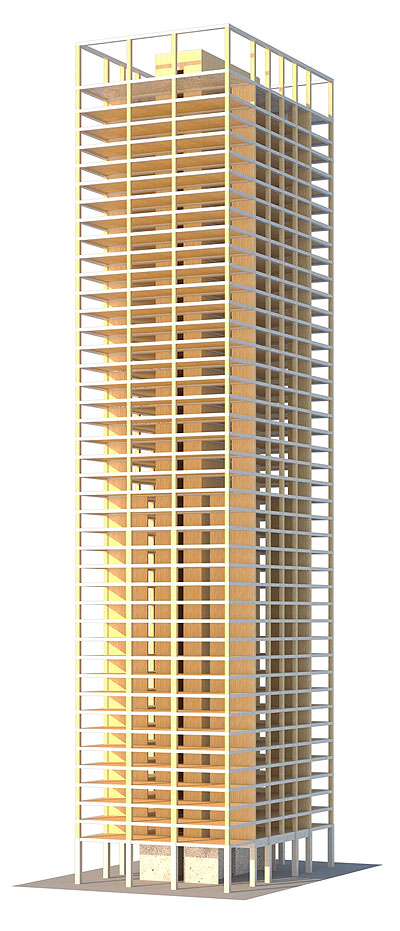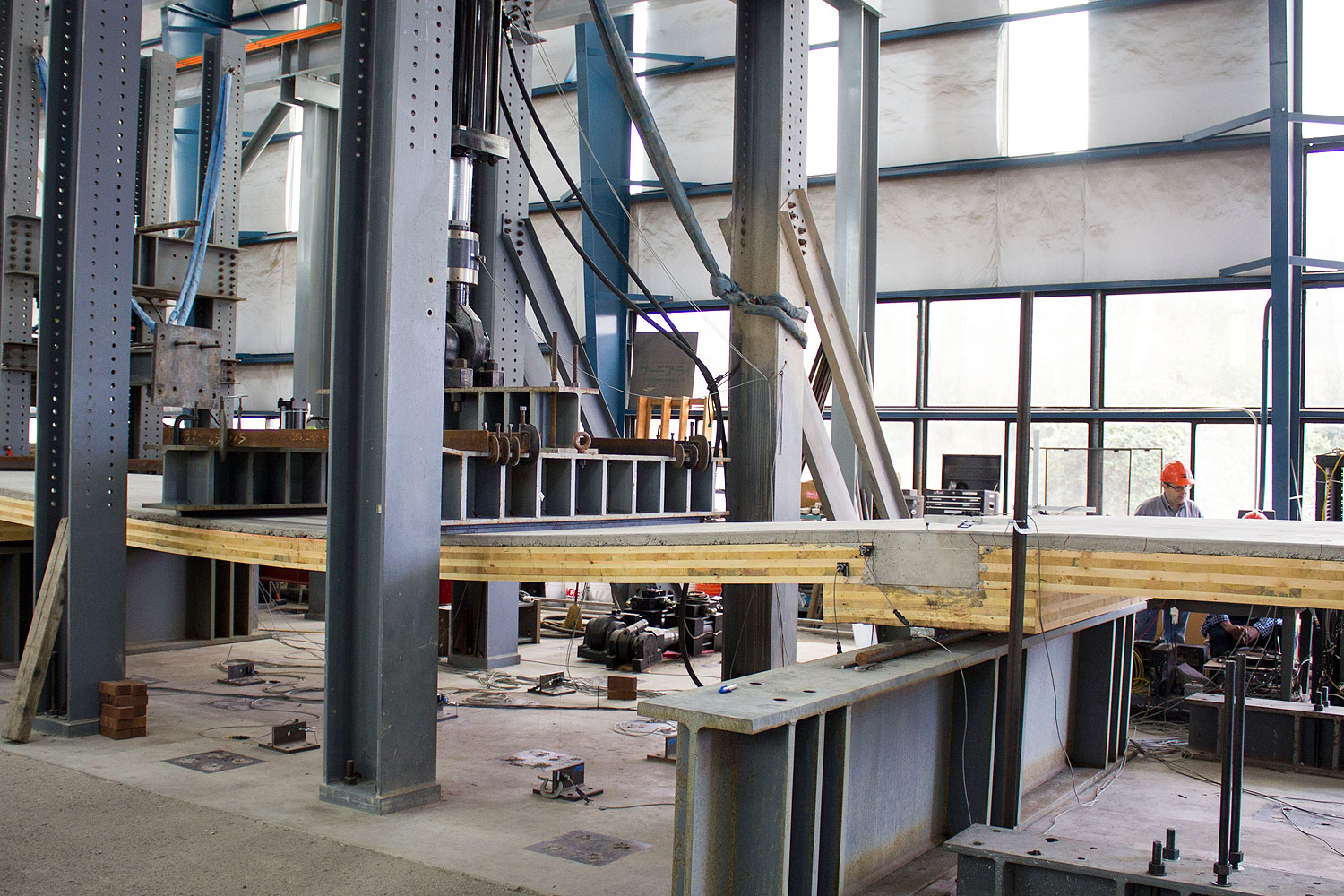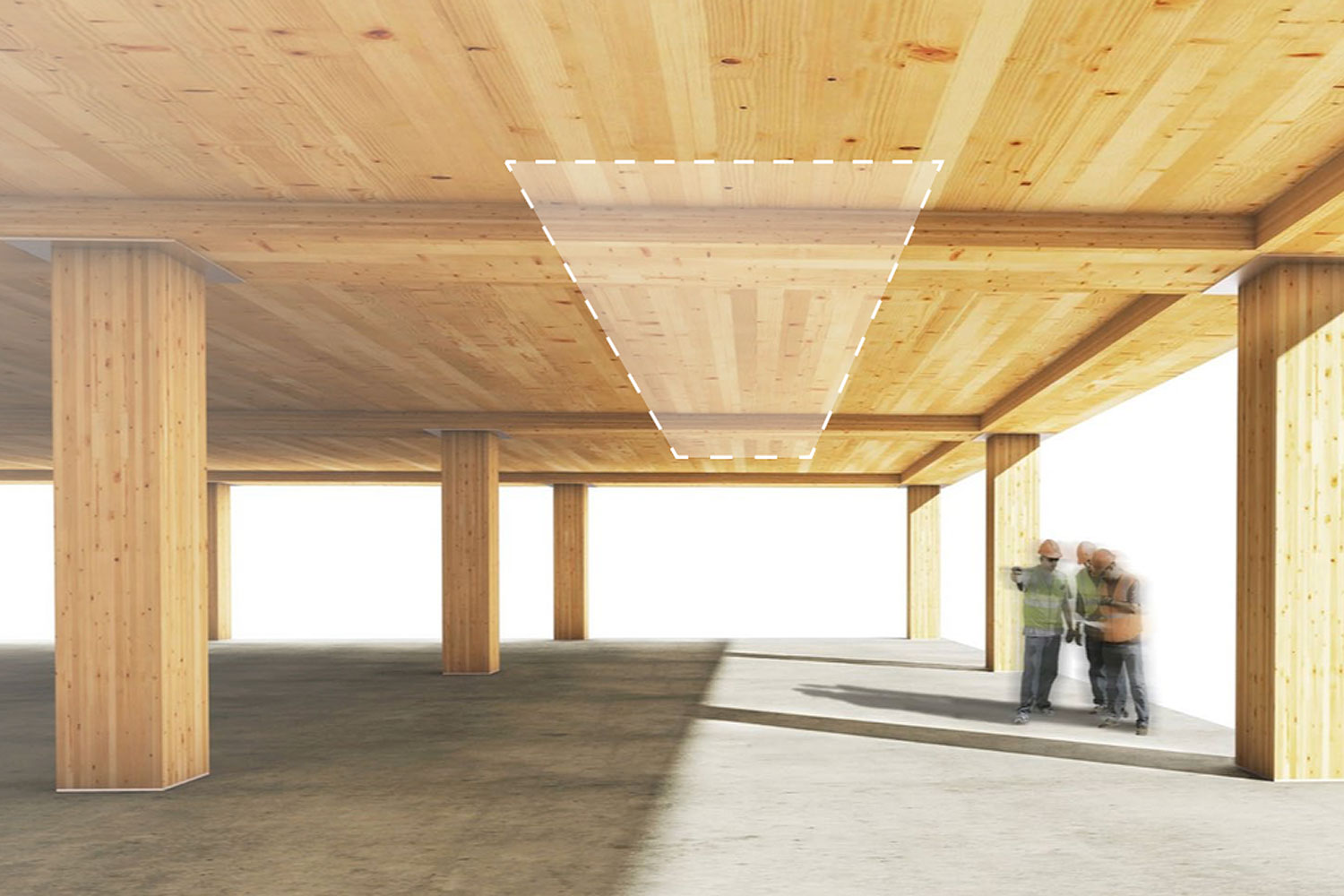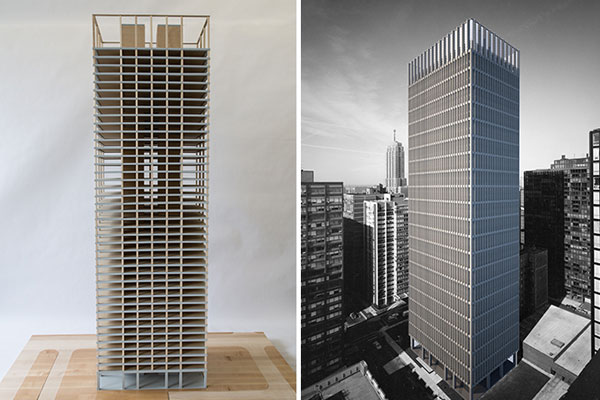A while back I was at Skidmore, Owings & Merrill for a story about the cutting edge of architecture: a 3D-printed building. While I was waiting in their lobby, I browsed a display of models from the firm's architects—new supertalls, a Chicago Architecture Biennial experiment, and so forth.
Among the wondrous designs was what looked like a straightforward Miesian skyscraper. It took a second to figure out what it was: a skyscraper made, mostly, out of wood. Among the models of architectural grace, it was an engineering idea, but it compelled me the most. It looked like this.

It was a prototype for a 42-story building made out of cross-laminated timber for the floors and laminated timber for the columns. It's a simple idea: smaller pieces of timber are glued together to make big pieces. It's an old idea, too; glued laminated (glulam) timber has been used for roofs and other structural elements since the mid-19th century, such as for the spectacular roof of the Richmond Olympic Oval. In South Dakota, there's a beautiful glulam highway bridge from the mid-20th century.
CLT is a newer technology, developed in the 1990s in Austria; wood is laid together so that the grain of each layer is perpendicular to the grain of the next, glued, and pressed, making it more rigid than regular laminated timber, where the grains run parallel.
"Cross-laminated timber has been a building product really used in Europe for the past 20 years or so, for all types of different construction," says Benton Johnson, the SOM associate who's leading the firm's Timber Tower project. "But in the United States, the material itself was being used primarily for temporary foundations, for construction access, things of that nature. It was used as more of a hard-working industrial product for a long time."
There's the Via Cenni complex in Milan, a 124-apartment complex; Bridport House, a 41-unit building in London; and the 10-story Forte building in Melbourne, the wood for which was shipped from Austria in 25 shipping containers. But that's the tallest CLT building that has been built.
"Once we really got to understanding the capabilities of cross-laminated timber, it became clear that these types of projects were viable from an engineering and architecture standpoint to heights far beyond what was allowable by code—meaning the material is so strong it can support a building that's very, very large," Johnson says.
The Timber Tower project passed its first major test recently: a 36-foot-by-8-foot floor section of CLT coated with reinforced concrete supported 82,000 pounds, exceeding required loads and structural expectations.
"You have to have a certain amount of floor stiffness, so the floors don't get too saggy," Johnson says. "Long-term, you don't want the partitions cracking. And you can't allow the floors to get too bouncy; people would get uncomfortable with them. We knew we had to hit a certain stiffness target that would allow us to design these floors to not deflect, to not vibrate too much. It ended up being stiffer than we needed."

The layer of concrete, about the depth of one of the wood layers, helps solve three issues SOM had to address with CLT.
"What we did is something unusual, something people haven't done to date, which is to think of the composite timber and concrete acting continuously to create a uniform flat-plate type structure," Johnson says. "It enhances the structural spanning characteristics, it enhances the acoustical characteristics, and it enhances the fire characteristics."
CLT is less massive than steel, so it absorbs less sound. The reinforced concrete cuts down on noise traveling from floor to floor, a common approach in timber buildings. But SOM took it a step further by making it a concrete-timber composite with the use of specially designed connectors to bind the two materials.
"If you're going to use this topping slab, we might as well make it composite and get some structural benefit out of it, and get some fire benefit out of it as well," Johnson says.
Fire is an intuitive concern with a wood building, but CLT is more fire-resistant than you might intuit. It is wood, and it does burn, but it burns slowly and predictably, and while it burns, it creates an insulating layer, which protects from some of the structural dangers with fire.
"When you're talking about fire resistance, there's three different ways it can fail. You can allow the fire to pass through the surface and spread to the level above and below; that would be called an integrity failure," Johnson says. There's a second type of failure, which is an insulation failure; if it gets too hot on the opposite side of the floor, on the opposite side of the wall, you can actually ignite something on the other side. It needs to have a certain amount of insulating quality. The last thing is the structural performance, making sure it has enough strength to support the loads for the required amount of time.
"The way the charring works is that it solves two out of those three in one behavior. Basically … [when] you have ignition on the timber surface, it'll burn, but the spent timber will form this charred layer. It's like charcoal. That charred layer insulates the structure, and the occupants on the other side, creating a fire barrier."
Having passed the load test, the SOM team will move on to testing their other calculations, beginning with a fire test. If it continues to pass, the Timber Tower will be realistic from an engineering standpoint. But to become a building, it has to be realistic from an economic standpoint as well.
One argument for the Timber Tower, and increased use of taller wood buildings in the United States more generally, is environmental impact. It's not just a renewable material; it's a carbon sink. SOM estimates that it would cut the building's embodied carbon footprint—all the carbon used to build the building, from extracting and making the materials, to transporting it, to building—by 60 to 75 percent. Bridport House is an example of how embodied-carbon savings compare to savings created by making a building more efficient in how it uses carbon once it's built:
Analysis undertaken by the company, working with the Centre for Sustainable Development at the University of Cambridge, calculated had the building been of conventional reinforced concrete frame, the materials required would have incurred an additional 892 tonnes of carbon.
The amount is equivalent to 12 years of operational energy required to heat and light all the dwellings at Bridport House; alternatively it would take 61 years to save the same amount of carbon as the planning requirement of 20 per cent renewables.
When the sequestered carbon locked up in the 1,576 m3 timber structure is added to the carbon avoided, the total figure is 2,113 tonnes of carbon – equivalent to 29 years of operational energy; with 20 per cent renewable energy, it would take 144 years to save the same amount of carbon.
This is why the Department of Agriculture threw a bit of money at the industry in the form of a wood-building contest, minimum 10 stories, last year. It had backing from two lumber groups, because it would benefit them as well; the domestic CLT industry is virtually non-existent. One U.S. firm is making architectural CLT, and two in Canada. It's use in buildings in the U.S. is also rare, though if you caught the Miesian wood pavilion as part of last year's Architecture Biennial, that was made from CLT.
But the technology, even scaled up, could have economic benefits in and of itself. Because it's light, foundations don't have to be as substantial; Bridport House is twice as tall as its predecessor but only 10 percent heavier. It could save money where earthquakes are a risk as well. "Another good example is if you have a building that's in a high-seismic zone, you might utilize a concrete core," Johnson says. "Well, if you have a lightweight building, just like it reduces weight on the foundation, it also reduces the seismic mass. So you end up saving all this cost and complexity in your core walls."

And it could be more efficient to build, as prefabrication can be done offsite while construction begins onsite, and then the project can be done with less labor onsite; Bridport House took about half the time of a concrete building. An AIA-led study found a 20 percent reduction in construction schedules, although the cost effectiveness was just a four percent savings across their sample.
But that could change. "When it comes down to costing these things, it's a little bit of a challenge, because the amount of material and where it comes from is still pretty scarce," Johnson says. A bigger market could mean more suppliers and reduced costs—and more contractors familiar with the technology.
"You have to make sure you have a contractor and a client that's actually committed to going through that proper exercise," Johnson says. "That's perhaps the more critical thing: When contractors aren't familiar with a building technology, there's a fear factor. 'I've never seen that, I don't know how complicated that is, what happens when it goes wrong'—they just haven't done it before. Challenging industry norms is perhaps one of the more challenging things."



